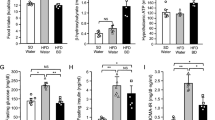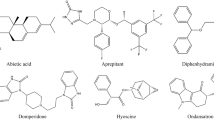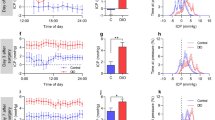Abstract
Tesofensine is a novel monoamine reuptake inhibitor that inhibits both norepinephrine, 5-HT, and dopamine (DA) reuptake function. Tesofensine is currently in clinical development for the treatment of obesity, however, the pharmacological basis for its strong effect in obesity management is not clarified. Using a rat model of diet-induced obesity (DIO), we characterized the pharmacological mechanisms underlying the appetite suppressive effect of tesofensine. DIO rats treated with tesofensine (2.0 mg/kg, s.c.) for 16 days showed significantly lower body weights than vehicle-treated DIO rats, being reflected by a marked hypophagic response. Using an automatized food intake monitoring system during a 12 h nocturnal test period, tesofensine-induced hypophagia was investigated further by studying the acute interaction of a variety of monoamine receptor antagonists with tesofensine-induced hypophagia in the DIO rat. Tesofensine (0.5–3.0 mg/kg, s.c.) induced a dose-dependent and marked decline in food intake with an ED50 of 1.3 mg/kg. The hypophagic response of tesofensine (1.5 mg/kg, s.c.) was almost completely reversed by co-administration of prazosin (1.0 mg/kg, α1 adrenoceptor antagonist) and partially antagonized by co-administration of SCH23390 (0.03 mg/kg, DA D1 receptor antagonist). In contrast, tesofensine-induced hypophagia was not affected by RX821002 (0.3 mg/kg, α2 adrenoceptor antagonist), haloperidol (0.03 mg/kg, D2 receptor antagonist), NGB2904 (0.1 mg/kg, D3 receptor antagonist), or ritanserin (0.03 mg/kg, 5-HT2A/C receptor antagonist). Hence, the mechanism underlying the suppression of feeding by tesofensine in the obese rat is dependent on the drug's ability to indirectly stimulate α1 adrenoceptor and DA D1 receptor function.
Similar content being viewed by others
Log in or create a free account to read this content
Gain free access to this article, as well as selected content from this journal and more on nature.com
or
References
Alberto CO, Trask RB, Quinlan ME, Hirasawa M (2006). Bidirectional dopaminergic modulation of excitatory synaptic transmission in orexin neurons. J Neurosci 26: 10043–10050.
Astrup A, Madsbad S, Breum L, Jensen TJ, Kroustrup JP, Larsen TM (2008a). Effect of tesofensine on bodyweight loss, body composition, and quality of life in obese patients: a randomised, double-blind, placebo-controlled trial. Lancet 372: 1906–1913.
Astrup A, Meier DH, Mikkelsen BO, Villumsen JS, Larsen TM (2008b). Weight loss produced by tesofensine in patients with Parkinson′s or Alzheimer′s disease. Obesity (Silver Spring) 16: 1363–1369.
Balcioglu A, Wurtman RJ (2000). Sibutramine, a serotonin uptake inhibitor, increases dopamine concentrations in rat striatal and hypothalamic extracellular fluid. Neuropharmacology 39: 2352–2359.
Billes SK, Cowley MA (2007). Inhibition of dopamine and norepinephrine reuptake produces additive effects on energy balance in lean and obese mice. Neuropsychopharmacology 32: 822–834.
Billes SK, Cowley MA (2008). Catecholamine reuptake inhibition causes weight loss by increasing locomotor activity and thermogenesis. Neuropsychopharmacology 33: 1287–1297.
Bina KG, Cincotta AH (2000). Dopaminergic agonists normalize elevated hypothalamic neuropeptide Y and corticotropin-releasing hormone, body weight gain, and hyperglycemia in ob/ob mice. Neuroendocrinology 71: 68–78.
Bray GA (2000). A concise review on the therapeutics of obesity. Nutrition 16: 953–960.
Clifton PG, Kennett GA (2006). Monoamine receptors in the regulation of feeding behaviour and energy balance. CNS Neurol Disord Drug Targets 5: 293–312.
Connoley IP, Liu YL, Frost I, Reckless IP, Heal DJ, Stock MJ (1999). Thermogenic effects of sibutramine and its metabolites. Br J Pharmacol 126: 1487–1495.
Davis LM, Michaelides M, Cheskin LJ, Moran TH, Aja S, Watkins PA et al (2008). Bromocriptine administration reduces hyperphagia and adiposity and differentially affects Dopamine D2 receptor and transporter binding in leptin-receptor-deficient zucker rats and rats with diet-induced obesity. Neuroendocrinology 89: 152–162.
Deupree JD, Burke WJ, Bylund DB (2008). Alpha-2 adrenergic-induced changes in rectal temperature in adult and 13-day old rats following acute and repeated desipramine administration. BMC Pharmacol 8: 17.
Durcan MJ, McWilliam JR, Campbell IC, Neale MC, Dunn G (1988). Chronic antidepressant drug regimes and food and water intake in rats. Pharmacol Biochem Behav 30: 299–302.
Fetissov SO, Meguid MM, Sato T, Zhang LH (2002). Expression of dopaminergic receptors in the hypothalamus of lean and obese Zucker rats and food intake. Am J Physiol Regul Integr Comp Physiol 283: R905–R910.
Gardier AM, Trouvin JH, Orosco M, Nicolaidis S, Jacquot C (1989). Effects of food intake and body weight on a serotonergic turnover index in rat hypothalamus. Brain Res Bull 22: 531–535.
Gehlert DR, Dreshfield L, Tinsley F, Benvenga MJ, Gleason S, Fuller RW et al (1998). The selective norepinephrine reuptake inhibitor, LY368975, reduces food consumption in animal models of feeding. J Pharmacol Exp Ther 287: 122–127.
Geiger BM, Behr GG, Frank LE, Caldera-Siu AD, Beinfeld MC, Kokkotou EG et al (2008). Evidence for defective mesolimbic dopamine exocytosis in obesity-prone rats. FASEB J 22: 2740–2746.
Glick SD, Haskew RE, Maisonneuve IM, Carlson JN, Jerussi TP (2000). Enantioselective behavioral effects of sibutramine metabolites. Eur J Pharmacol 397: 93–102.
Golozoubova V, Strauss F, Malmlof K (2006). Locomotion is the major determinant of sibutramine-induced increase in energy expenditure. Pharmacol Biochem Behav 83: 517–527.
Grignaschi G, Fanelli E, Scagnol I, Samanin R (1999). Studies on the role of serotonin receptor subtypes in the effect of sibutramine in various feeding paradigms in rats. Br J Pharmacol 127: 1190–1194.
Halford JC, Harrold JA, Boyland EJ, Lawton CL, Blundell JE (2007). Serotonergic drugs : effects on appetite expression and use for the treatment of obesity. Drugs 67: 27–55.
Heal DJ, Cheetham SC, Prow MR, Martin KF, Buckett WR (1998). A comparison of the effects on central 5-HT function of sibutramine hydrochloride and other weight-modifying agents. Br J Pharmacol 125: 301–308.
Jackson HC, Bearham MC, Hutchins LJ, Mazurkiewicz SE, Needham AM, Heal DJ (1997). Investigation of the mechanisms underlying the hypophagic effects of the 5-HT and noradrenaline reuptake inhibitor, sibutramine, in the rat. Br J Pharmacol 121: 1613–1618.
Kraszewski KZ, Cincotta AH (2000). Increased responsiveness of ventromedial hypothalamic neurons to norepinephrine in obese versus lean mice: relation to the metabolic syndrome. Int J Mol Med 5: 349–355.
Kung MP, Choi SR, Hou C, Zhuang ZP, Foulon C, Kung HF (2004). Selective binding of 2-[125I]iodo-nisoxetine to norepinephrine transporters in the brain. Nucl Med Biol 31: 533–541.
Kuo DY (2002). Co-administration of dopamine D1 and D2 agonists additively decreases daily food intake, body weight and hypothalamic neuropeptide Y level in rats. J Biomed Sci 9: 126–132.
Lehr T, Staab A, Tillmann C, Nielsen EO, Trommeshauser D, Schaefer HG et al (2008). Contribution of the active metabolite M1 to the pharmacological activity of tesofensine in vivo: a pharmacokinetic-pharmacodynamic modelling approach. Br J Pharmacol 153: 164–174.
Levin BE, Keesey RE (1998). Defense of differing body weight set points in diet-induced obese and resistant rats. Am J Physiol 274: R412–R419.
Liu YL, Connoley IP, Heal DJ, Stock MJ (2004). Pharmacological characterisation of the thermogenic effect of bupropion. Eur J Pharmacol 498: 219–225.
McQuade JA, Benoit SC, Woods SC, Seeley RJ (2003). 7-OH-DPAT selectively reduces intake of both chow and high fat diets in different food intake regimens. Pharmacol Biochem Behav 76: 517–523.
McQuade JA, Benoit SC, Xu M, Woods SC, Seeley RJ (2004). High-fat diet induced adiposity in mice with targeted disruption of the dopamine-3 receptor gene. Behav Brain Res 151: 313–319.
Meguid MM, Fetissov SO, Blaha V, Yang ZJ (2000a). Dopamine and serotonin VMN release is related to feeding status in obese and lean Zucker rats. Neuroreport 11: 2069–2072.
Meguid MM, Fetissov SO, Varma M, Sato T, Zhang L, Laviano A et al (2000b). Hypothalamic dopamine and serotonin in the regulation of food intake. Nutrition 16: 843–857.
Meguid MM, Yang ZJ, Laviano A (1997). Meal size and number: relationship to dopamine levels in the ventromedial hypothalamic nucleus. Am J Physiol 272: R1925–R1930.
Mori RC, Guimaraes RB, Nascimento CM, Ribeiro EB (1999). Lateral hypothalamic serotonergic responsiveness to food intake in rat obesity as measured by microdialysis. Can J Physiol Pharmacol 77: 286–292.
Morien A, McMahon L, Wellman PJ (1993). Effects on food and water intake of the alpha 1-adrenoceptor agonists amidephrine and SK&F-89748. Life Sci 53: 169–174.
Morien A, Wellman PJ, Fojt J (1995). Diurnal rhythms of paraventricular hypothalamic norepinephrine and food intake in rats. Pharmacol Biochem Behav 52: 169–174.
Nelson DL, Gehlert DR (2006). Central nervous system biogenic amine targets for control of appetite and energy expenditure. Endocrine 29: 49–60.
Orosco M, Nicolaidis S (1992). Spontaneous feeding-related monoaminergic changes in the rostromedial hypothalamus revealed by microdialysis. Physiol Behav 52: 1015–1019.
Orosco M, Rouch C, Meile MJ, Nicolaidis S (1995). Spontaneous feeding-related monoamine changes in rostromedial hypothalamus of the obese Zucker rat: a microdialysis study. Physiol Behav 57: 1103–1106.
Pfeffer AO, Samson HH (1988). Haloperidol and apomorphine effects on ethanol reinforcement in free feeding rats. Pharmacol Biochem Behav 29: 343–350.
Pothos EN, Sulzer D, Hoebel BG (1998). Plasticity of quantal size in ventral midbrain dopamine neurons: possible implications for the neurochemistry of feeding and reward. Appetite 31: 405.
Racotta R, Soto-Mora LM (1993). Specificity of alpha- and beta-adrenergic inhibition of water and food intake. Physiol Behav 53: 361–365.
Rittenhouse PA, Bakkum EA, Levy AD, Li Q, Carnes M, van de Kar LD (1994). Evidence that ACTH secretion is regulated by serotonin2A/2C (5-HT2A/2C) receptors. J Pharmacol Exp Ther 271: 1647–1655.
Scislowski PW, Tozzo E, Zhang Y, Phaneuf S, Prevelige R, Cincotta AH (1999). Biochemical mechanisms responsible for the attenuation of diabetic and obese conditions in ob/ob mice treated with dopaminergic agonists. Int J Obes Relat Metab Disord 23: 425–431.
Shimizu H, Fisler S, Bray GA (1994). Extracellular hypothalamic monoamines measured by in vivo microdialysis in a rat model of dietary fat-induced obesity. Obes Res 2: 100–109.
Spiller K, Xi ZX, Peng XQ, Newman AH, Ashby Jr CR, Heidbreder C et al (2008). The selective dopamine D3 receptor antagonists SB-277011A and NGB 2904 and the putative partial D3 receptor agonist BP-897 attenuate methamphetamine-enhanced brain stimulation reward in rats. Psychopharmacology (Berl) 196: 533–542.
Stanley BG, Schwartz DH, Hernandez L, Hoebel BG, Leibowitz SF (1989). Patterns of extracellular norepinephrine in the paraventricular hypothalamus: relationship to circadian rhythm and deprivation-induced eating behavior. Life Sci 45: 275–282.
Volkow ND, Wise RA (2005). How can drug addiction help us understand obesity? Nat Neurosci 8: 555–560.
Wellman PJ (2000). Norepinephrine and the control of food intake. Nutrition 16: 837–842.
Wellman PJ (2005). Modulation of eating by central catecholamine systems. Curr Drug Targets 6: 191–199.
Wellman PJ, Davies BT (1992). Reversal of cirazoline- and phenylpropanolamine-induced anorexia by the alpha 1-receptor antagonist prazosin. Pharmacol Biochem Behav 42: 97–100.
Wilmot CA, Sullivan AC, Levin BE (1988). Effects of diet and obesity on brain alpha 1- and alpha 2-noradrenergic receptors in the rat. Brain Res 453: 157–166.
Wortley KE, Hughes ZA, Heal DJ, Stanford SC (1999). Comparison of changes in the extracellular concentration of noradrenaline in rat frontal cortex induced by sibutramine or d-amphetamine: modulation by alpha2-adrenoceptors. Br J Pharmacol 127: 1860–1866.
Yang ZJ, Meguid MM, Chai JK, Chen C, Oler A (1997). Bilateral hypothalamic dopamine infusion in male Zucker rat suppresses feeding due to reduced meal size. Pharmacol Biochem Behav 58: 631–635.
Young 3rd WS, Kuhar MJ (1980). Noradrenergic alpha 1 and alpha 2 receptors: light microscopic autoradiographic localization. Proc Natl Acad Sci USA 77: 1696–1700.
Acknowledgements
The authors thank Tine Østergaard Engelbrect and Peter Buhl for skillfull technical assistance.
Author information
Authors and Affiliations
Corresponding author
Ethics declarations
Competing interests
This study was funded by NeuroSearch. The authors (AMDA, JDM, HHH) declare that, except for income received from our primary employer, no financial support or compensation has been received from any individual or corporate entity over the past 3 years for research or professional service and there are no personal financial holdings that could be perceived as constituting a potential conflict of interest.
Rights and permissions
About this article
Cite this article
Axel, A., Mikkelsen, J. & Hansen, H. Tesofensine, a Novel Triple Monoamine Reuptake Inhibitor, Induces Appetite Suppression by Indirect Stimulation of α1 Adrenoceptor and Dopamine D1 Receptor Pathways in the Diet-Induced Obese Rat. Neuropsychopharmacol 35, 1464–1476 (2010). https://doi.org/10.1038/npp.2010.16
Received:
Revised:
Accepted:
Published:
Issue date:
DOI: https://doi.org/10.1038/npp.2010.16
Keywords
This article is cited by
-
The Fight Against Obesity Escalates: New Drugs on the Horizon and Metabolic Implications
Current Obesity Reports (2020)
-
Pharmacotherapy of Obesity: Limits and Perspectives
American Journal of Cardiovascular Drugs (2019)
-
Centrally Acting Agents for Obesity: Past, Present, and Future
Drugs (2018)
-
Dopamine–prolactin pathway potentially contributes to the schizophrenia and type 2 diabetes comorbidity
Translational Psychiatry (2016)
-
Cerebral Markers of the Serotonergic System in Rat Models of Obesity and After Roux‐en‐Y Gastric Bypass
Obesity (2012)



